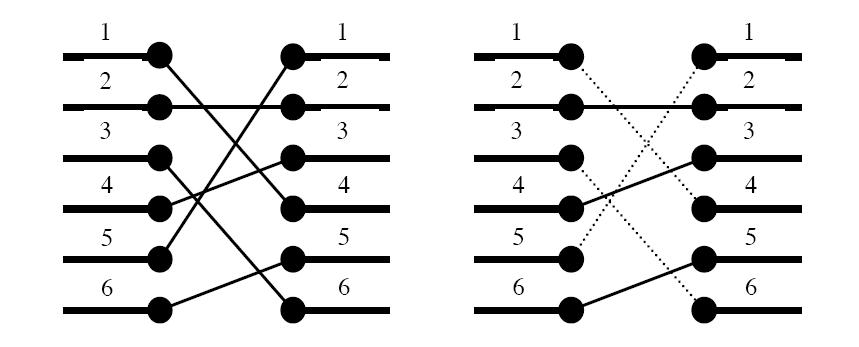Bridging signals
Time Limit: 5000/1000 MS (Java/Others) Memory Limit: 65536/32768 K (Java/Others)
Total Submission(s): 2582 Accepted Submission(s): 1665
Problem Description
'Oh no, they've done it again', cries the chief designer at the Waferland chip factory. Once more the routing designers have screwed up completely, making the signals on the chip connecting the ports of two functional blocks cross each other all over the place. At this late stage of the process, it is too
expensive to redo the routing. Instead, the engineers have to bridge the signals, using the third dimension, so that no two signals cross. However, bridging is a complicated operation, and thus it is desirable to bridge as few signals as possible. The call for a computer program that finds the maximum number of signals which may be connected on the silicon surface without rossing each other, is imminent. Bearing in mind that there may be housands of signal ports at the boundary of a functional block, the problem asks quite a lot of the programmer. Are you up to the task?

Figure 1. To the left: The two blocks' ports and their signal mapping (4,2,6,3,1,5). To the right: At most three signals may be routed on the silicon surface without crossing each other. The dashed signals must be bridged.
A typical situation is schematically depicted in figure 1. The ports of the two functional blocks are numbered from 1 to p, from top to bottom. The signal mapping is described by a permutation of the numbers 1 to p in the form of a list of p unique numbers in the range 1 to p, in which the i:th number pecifies which port on the right side should be connected to the i:th port on the left side.
Two signals cross if and only if the straight lines connecting the two ports of each pair do.
expensive to redo the routing. Instead, the engineers have to bridge the signals, using the third dimension, so that no two signals cross. However, bridging is a complicated operation, and thus it is desirable to bridge as few signals as possible. The call for a computer program that finds the maximum number of signals which may be connected on the silicon surface without rossing each other, is imminent. Bearing in mind that there may be housands of signal ports at the boundary of a functional block, the problem asks quite a lot of the programmer. Are you up to the task?

Figure 1. To the left: The two blocks' ports and their signal mapping (4,2,6,3,1,5). To the right: At most three signals may be routed on the silicon surface without crossing each other. The dashed signals must be bridged.
A typical situation is schematically depicted in figure 1. The ports of the two functional blocks are numbered from 1 to p, from top to bottom. The signal mapping is described by a permutation of the numbers 1 to p in the form of a list of p unique numbers in the range 1 to p, in which the i:th number pecifies which port on the right side should be connected to the i:th port on the left side.
Two signals cross if and only if the straight lines connecting the two ports of each pair do.
Input
On the first line of the input, there is a single positive integer n, telling the number of test scenarios to follow. Each test scenario begins with a line containing a single positive integer p<40000, the number of ports on the two functional blocks. Then follow p lines, describing the signal mapping: On the i:th line is the port number of the block on the right side which should be connected to the i:th port of the block on the left side.
Output
For each test scenario, output one line containing the maximum number of signals which may be routed on the silicon surface without crossing each other.
Sample Input
4
6
4
2
6
3
1
5
10
2
3
4
5
6
7
8
9
10
1
8
8
7
6
5
4
3
2
1
9
5
8
9
2
3
1
7
4
6
Sample Output
3 9 1 4
题目大意
求最长上升子序列,数据范围略大。
分析
n方的算法可能会超时,所以用nlogn的算法。
f[i]表示的长度为i的子序列的结尾最小值是多少,每加入一个值时更新,可以用二分查找优化。
我的另一种想法:
可以维护一个set<pair<int,int> > ,pair中的第一个数是值,第二个是坐标,二分查找小于当前值,且坐标也小于当前坐标的最大的数,更新。
code
1 #include<cstdio> 2 #include<cstring> 3 #include<algorithm> 4 using namespace std; 5 6 int a[50010],f[50010]; 7 8 int main() 9 { 10 int t,n,len; 11 scanf("%d",&t); 12 while (t--) 13 { 14 scanf("%d",&n); 15 for (int i=1; i<=n; ++i) scanf("%d",&a[i]); 16 len = 1; 17 f[1] = a[1]; 18 for (int i=2; i<=n; ++i) 19 { 20 if (a[i]>f[len]) f[++len] = a[i]; 21 else 22 { 23 int pos = lower_bound(f+1,f+len+1,a[i]) - f; 24 f[pos] = a[i]; 25 } 26 } 27 printf("%d ",len); 28 } 29 return 0; 30 }
推荐一篇文章:http://blog.csdn.net/shuangde800/article/details/7474903